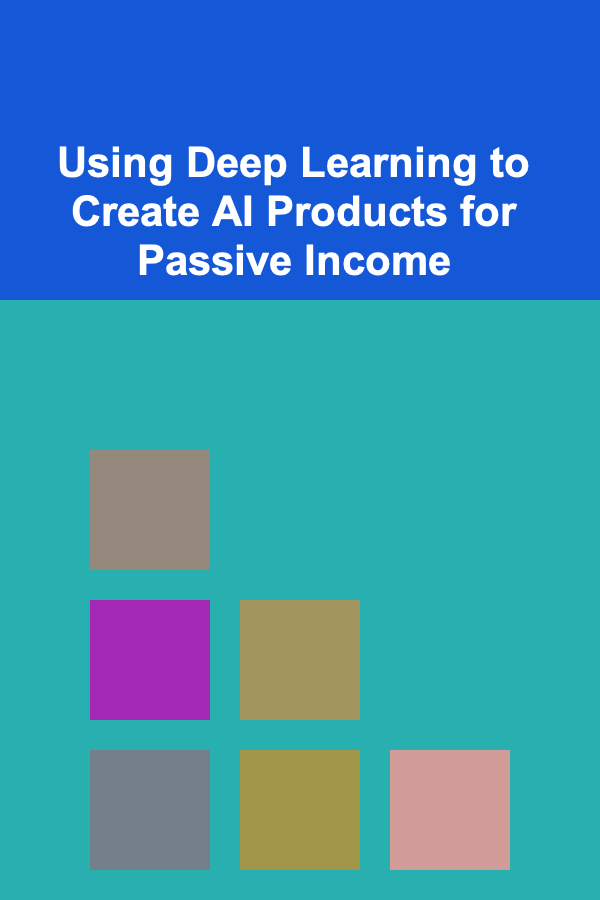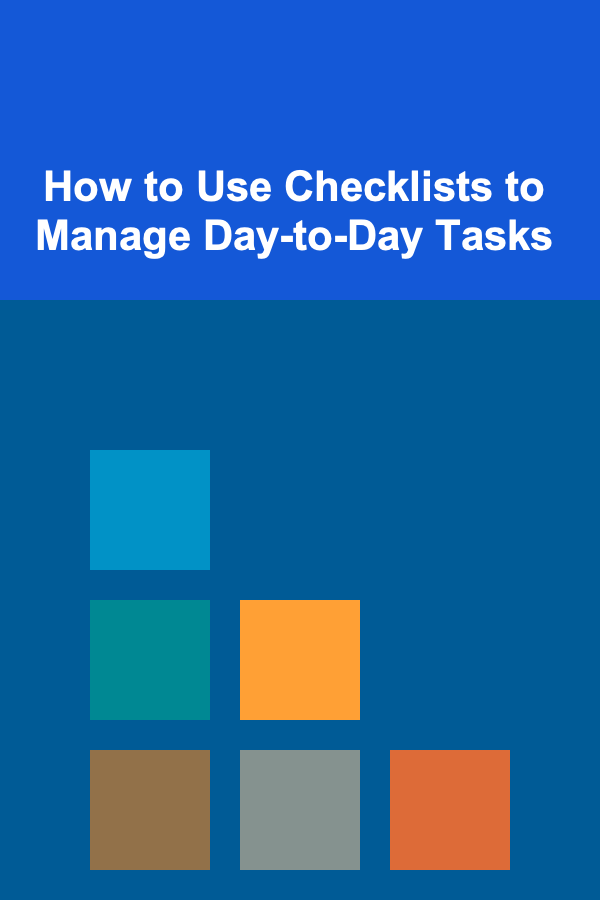
Using Deep Learning to Create AI Products for Passive Income
ebook include PDF & Audio bundle (Micro Guide)
$12.99$10.99
Limited Time Offer! Order within the next:

The rapid rise of artificial intelligence (AI) and machine learning, particularly deep learning, has opened up new avenues for entrepreneurs and developers to create AI-powered products that generate passive income. Deep learning, a subset of machine learning that focuses on neural networks with many layers, is the driving force behind significant breakthroughs in areas like computer vision, natural language processing (NLP), and speech recognition.
If you're someone with expertise in deep learning, you're in a prime position to create and monetize AI products in various ways. The best part? Many of these avenues can generate passive income---allowing you to earn money while you sleep. In this article, we'll explore how deep learning can be used to create AI products that lead to passive income streams, discussing everything from model creation and deployment to market strategies and monetization.
The Foundation: What is Deep Learning?
Before diving into how you can leverage deep learning for passive income, it's essential to understand the basics. Deep learning is a branch of machine learning that involves using neural networks with many layers (hence the term "deep"). These networks are capable of learning from vast amounts of data and making predictions or decisions based on patterns within the data.
Deep learning algorithms are designed to automatically extract features from data, allowing them to perform tasks like image recognition, sentiment analysis, language translation, and even driving autonomous vehicles. The main advantage of deep learning models is their ability to improve over time as they are exposed to more data, making them extremely powerful for real-world applications.
Passive Income from AI Products: How Does it Work?
The idea of passive income revolves around creating a product or service that generates income with minimal ongoing effort after the initial setup. AI products, particularly those based on deep learning, can be a great fit for generating passive income because they often rely on continuous data input and automated decision-making once they're deployed.
To create a deep learning-based AI product for passive income, you will need to:
- Develop a Deep Learning Model: Build a deep learning model that can perform a specific task---whether it's recognizing objects in images, analyzing sentiment in text, or forecasting future trends based on historical data.
- Automate the Process: Set up systems that allow your AI product to operate autonomously, so it can provide value without constant intervention.
- Monetize the Product: Once your AI product is live and generating value, you can monetize it through various methods, such as subscription models, one-time payments, or usage-based pricing.
Now, let's explore specific AI product ideas that leverage deep learning to generate passive income.
AI-Based Image Recognition Tools
Image recognition is one of the most common applications of deep learning. By training deep learning models to analyze images, you can create products that automatically classify or detect objects in images and videos. These products can serve a wide range of industries, including e-commerce, healthcare, security, and more.
Example: AI-Powered Image Classification for E-Commerce
E-commerce platforms often require efficient image recognition tools to tag and categorize products. By developing an AI-powered image classification tool, you can offer this service to online store owners. The model can automatically classify products based on images, reducing manual tagging efforts and improving searchability within e-commerce platforms.
Monetization Strategy:
- Subscription Model: Offer the image classification service as a SaaS (Software as a Service) product, charging a monthly or yearly subscription fee for access to the tool.
- Pay-per-Use: Alternatively, you could charge clients based on the number of images they need processed, providing flexibility for businesses of different sizes.
Example: AI for Medical Imaging
Medical imaging analysis, which includes detecting anomalies in X-rays, MRIs, and CT scans, is another lucrative area where deep learning excels. You can create a tool that automates the process of identifying common conditions, such as tumors or fractures, within medical images. Although creating such a tool may require collaboration with medical professionals and strict adherence to regulatory standards, the potential passive income from licensing the technology or offering it as a subscription service is significant.
Monetization Strategy:
- Licensing: License your tool to healthcare organizations or diagnostic centers on a per-use or subscription basis.
- Partnerships with Hospitals: Collaborate with hospitals to implement your solution within their medical systems.
AI-Powered Content Generation Tools
Natural language processing (NLP), another key area of deep learning, involves building models that can understand, generate, and manipulate human language. There are numerous ways deep learning can be applied to generate passive income through content creation.
Example: AI-Based Copywriting Tools
AI-powered copywriting tools like GPT-3 (developed by OpenAI) have become widely used for generating written content in various industries. If you have access to or can fine-tune an existing model, you can create a tool that generates high-quality blog posts, social media content, or marketing copy. Many businesses rely on content creation to engage customers, and automating this process through AI can save them significant time and effort.
Monetization Strategy:
- Subscription Model: Offer access to your tool through a subscription service, where users pay monthly to generate a set number of articles or pieces of content.
- Freemium Model: Offer a free version of your tool with limited functionality (e.g., a restricted number of words per month) and charge for premium features like additional word count, plagiarism checks, or SEO optimization.
Example: AI for Automated News Generation
Another exciting opportunity is building an AI-powered news generation tool. With advances in NLP and deep learning, it's possible to build an AI that can pull data from various sources, synthesize it, and generate coherent news stories or summaries. This tool could be used to automatically generate content for niche news websites or blogs.
Monetization Strategy:
- Ad Revenue: You can monetize the generated content through advertising revenue on your website, similar to how news websites earn money from ads.
- Content Subscription: Offer users access to exclusive news reports or summaries for a subscription fee.
AI-Based Financial Forecasting Tools
Deep learning models are also highly effective in analyzing financial data and making predictions. These models can be used to forecast stock prices, analyze market trends, and predict economic indicators.
Example: AI for Stock Market Predictions
Many individuals and businesses are interested in using AI to predict stock market trends or identify lucrative investment opportunities. By training a deep learning model on historical market data, you can build a tool that predicts future market movements or identifies undervalued stocks.
Monetization Strategy:
- Subscription: Charge users a subscription fee for access to the predictions, either via a website or an API.
- Affiliate Marketing: You can partner with brokers or trading platforms and earn a commission for each user who signs up through your platform.
Example: Real Estate Investment Predictions
Similarly, you could use deep learning to predict trends in real estate markets. A model trained on historical property prices, economic indicators, and market conditions could offer predictions about future price movements, helping investors make informed decisions.
Monetization Strategy:
- Subscription or Pay-per-Report: Offer real estate forecasts on a subscription basis or charge users for individual reports or analyses.
- Affiliate Marketing with Real Estate Platforms: Partner with real estate platforms to earn a commission for every user who makes a property investment based on your predictions.
AI for Personalized Recommendations
Recommendation systems powered by deep learning are another great source of passive income. These systems are used by major platforms like Netflix, Amazon, and Spotify to suggest products, movies, music, or books to users based on their preferences.
Example: Personalized Shopping Assistant
Develop a deep learning-powered recommendation engine that can be integrated into e-commerce platforms. Your system could recommend products to customers based on their browsing history, previous purchases, and preferences.
Monetization Strategy:
- Affiliate Marketing: Partner with e-commerce platforms or retailers and earn a commission for every sale that results from your recommendations.
- Licensing: License your recommendation system to other businesses, charging them based on usage or traffic volume.
Example: AI-Powered Content Recommendations
In addition to e-commerce, recommendation systems are also highly effective in content platforms. You could create an AI-powered recommendation system that suggests blog posts, videos, or podcasts to users based on their interests.
Monetization Strategy:
- Ad Revenue: If you operate a content platform, you can monetize your recommendations through advertising revenue.
- Subscription-Based Model: Alternatively, you could charge users a subscription fee to access premium recommendations or personalized content experiences.
AI Chatbots for Customer Support
Customer support is another area where deep learning can create passive income. AI-powered chatbots, which use NLP models to converse with customers, are increasingly being used to automate customer service functions.
Example: AI Chatbot for Small Businesses
You can develop an AI chatbot that provides customer support for small businesses, answering common questions, handling inquiries, and solving basic issues. The chatbot can be integrated with the business's website or social media accounts, and businesses can use it to offer 24/7 customer support without hiring a large support team.
Monetization Strategy:
- Subscription Model: Offer businesses a subscription plan where they pay for access to the chatbot service.
- Freemium Model: Offer a free version of the chatbot with basic functionality, and charge for premium features like advanced analytics, multilingual support, or custom branding.
Example: AI for Mental Health Support
AI chatbots can also be used in mental health applications. You could create a chatbot that provides basic emotional support, offering resources and guidance to individuals experiencing stress, anxiety, or depression. Such tools can be used by mental health professionals or integrated into wellness platforms.
Monetization Strategy:
- Subscription: Offer access to the chatbot through a subscription model, either for individuals or for businesses that want to integrate it into their mental health offerings.
Conclusion
Deep learning provides a wide range of opportunities for creating AI-powered products that generate passive income. Whether you're building image recognition tools, content generation platforms, financial forecasting models, or personalized recommendation engines, there are numerous ways to leverage deep learning to create products that can generate continuous income with minimal ongoing effort.
The key to success in this space lies in choosing a niche that you are passionate about and capable of serving, building a high-quality AI product, and implementing a smart monetization strategy. With the right approach, you can harness the power of deep learning to build scalable, passive income-generating AI products that have a lasting impact.
Other Products

How to Create a Travel Recipe Book for Your Adventures
Read More
How to Keep Your Drawer Tools Clean and Organized
Read More
How to Use Checklists to Manage Day-to-Day Tasks
Read More
Networking 101: Building Connections that Boost Your Career
Read More
Top 10 Free Community Events You Can't Miss This Year
Read More